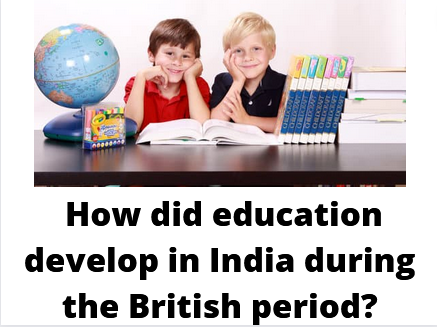The beginning of modern education started only after the arrival of the British in India when Lord Macaulay recommended teaching through English medium in the 19th century. Most taught the same curriculum as public schools. The British government started the propagation of Christianity in India through missionary organizations in India, these preachers used to give speeches to the people through English medium. Some taught courses through local languages with English as a second language. The term “pre-modern” was used for three types of schools. Muslim or Hindu sacred literature was taught in Arabic and Sanskrit schools, while Persian literature was taught in Persian schools. Local schools across India taught reading and writing the local language and arithmetic. With the passage of 150 years, the merchant East India Company began to rule. The company remained indifferent to education for fear of impediment to expansion. Nevertheless, for a specific reason and purpose, the ‘Calcutta Madrasa’ at Calcutta in 1781 and the ‘Sanskrit College’ at Banaras was established by Jonathan Duncan in 1781 by the Company. The company’s policy regarding publicity also started changing. The company is now beginning to understand the need to educate the Indians of its state. So let’s know friends, how did education develop during the British period in India?
Oriental Education 1813
As a result of decades of lobbying by the likes of William Wilberforce and Charles Grant, the 1813 renewal of the East India Company’s charter imposed, in addition to the company’s corporate activities, the duty of educating and assisting previously excommunicated Christian missionaries to educate the population. Fulfilled. Company officials were divided as to how to enforce this imposed duty, with the Orientalists, who believed that education should be in Indian languages (of which they favored classical or court languages such as Sanskrit or Persian ), while utilitarians (also called Anglicists) like Lord William Bentinck and Thomas Macaulay, firmly believed that traditional India had nothing to teach about modern skills, the best education for them would be in English . Macaulay called for an education system—now known as Macaulayism—that would create a class of English Indians who would act as cultural mediators between the British and the Indians.
Macaulay’s Education 1835
Lord Macaulay came to India in the year 1834 and was appointed as a Law Member of the Executive Council of the Governor General. He was appointed to the post of chairman of the Committee on Public Education, whose function was to mediate oriental and western disputes.
In the year 1835, Lord Macaulay presented his famous minutes to the Governor-General’s Council, which was accepted by Lord William Bentinck and passed the English Education Act, 1835.
The Efforts of James Thomson (1843–53)
James Thomson, the Lieutenant Governor of the North-Western Provinces of British India, implemented a comprehensive plan for the development of rural education in the local language.
Under this, mainly practical subjects such as mensuration, agricultural science, etc. were taught.
The main objective of James Thomson’s efforts was to meet the staff requirement for the newly established Revenue and Public Works Department.
Wood’s Manifesto on Education, 1854
Charles Wood was the chairman of the Board of Control of the East India Company. He prepared a detailed plan to improve the education system in India, it was called Wood’s Dispatch. Which was implemented by the then Governor General Lord Dalhousie. In this resolution, thoughts on the purpose, medium, reforms etc. of education were expressed. This manifesto is called ‘Magna Carta of Indian Education’.
- The medium of higher education should be English and the medium of instruction of the general public should be the mother tongue.
- Private enterprises should be encouraged in the field of education.
- Western education should be widely spread.
- Universities should be opened in Calcutta, Bombay and Madras on the lines of University of London.
- Whose job is only to give exams.
- Technical schools and colleges should be established.
- Teacher-training institutes should be established and emphasis should be given on women’s education.
- Education department should be established in every province.
- Government education should be completely secular in nature.
Early 19th century surveys
According to Sir Thomas Munro’s Minutes on Basic Education, in 1822 and 1826, there were 11,447 schools in the Madras Presidency, and 740 centers for higher education in the Presidency, except for a few European missionary schools that were funded and managed at the community level. Was. The number of students enrolled was 161,667, of whom 147–644 were boys, and 5.022 girls, or 1 in 3 boys of school age, 1 in 8 boys identified by a similar practice in the Bombay Presidency. , ,
Adam reported in his study that around 1843 there were about 10,000 rural schools in the Bengal Presidency, with an estimated 13.2% of boys attending these schools. However, the standard of education was criticized as rudimentary, well below European standards, and little more than a cultivated memory.In Punjab, Dr. Leitner, principal of the Oriental College and Government College, Lahore, estimated that there were at least 30,000 schools in 1854–1855, and the total number of pupils was about four lakh, assuming 13 pupils per school. Area. Munro’s critique of 1826 also covered wealth and teacher quality in the traditional system, with the claim that the average teacher in Madras earned 4 to 8 teachers per student, with no more than Rs 6 or 7 monthly from Anna’s fees. . Capacity. In the Presidency, the British wanted the East India Company to build new schools, textbooks and provide teachers in the new schools a stipend of 9 to 15 rupees to supplement their income from tuition fees. After the introduction of British education, there was a drastic reduction in the number of these indigenous educational institutions.
